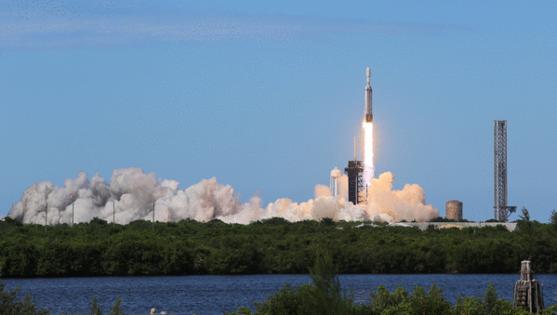Powerhouse hurricane watchdog satellite launches aboard SpaceX Falcon Heavy
Published in Science & Technology News
CAPE CANAVERAL, Fla. — The last of a series of hurricane-hunting satellites got its most powerful ride ever to space Tuesday aboard a SpaceX Falcon Heavy.
The rocket that is essentially three Falcon 9’s strapped together blasted off from Kennedy Space Center’s Launch Pad 39-A at 5:26 p.m. Eastern time carrying the 11,000-pound GOES-U satellite for the National Oceanic and Atmospheric Administration, partnered with NASA.
Weather worries proved unfounded for the launch site as teams threaded the needle of afternoon thunderstorms to take flight amid blue skies to the cheers of gathered crowds.
About eight minutes after liftoff – with a kettle of vultures taking flight to get out of the way – two of the three boosters for Falcon Heavy made a recovery touchdown back at nearby Cape Canaveral Space Force Station’s Landing Zones 1 and 2. Their supersonic return knocked out a pair of double sonic booms that set off car alarms and struck a unique whistling reverb sound off the massive Vehicle Assembly Building.
The center core booster will crash into the Atlantic with no recovery planned.
Expending the center core is needed to send GOES-U to a transfer orbit that will take it to an ultimate destination 22,000 miles away from Earth. Deployment won’t come until 4 1/2 hours after launch.
With 5.1 million pounds of thrust at liftoff, Falcon Heavy bested the power of the ULA Atlas V rockets that gave a ride to the previous three GOES satellites.
“This is an incredibly high energy orbit that necessitates an incredibly powerful rocket to get there,” said SpaceX’s Julianna Scheiman, director of its NASA Science Missions program. She said SpaceX worked with NASA’s launch services and Lockheed Martin, which built the GOES satellite, to optimize its propellant over its lifetime.
“The number of years our normal spacecraft specification lifetime is 15 years. With the added capability that the Falcon Heavy is giving us we expect to be 20 plus years of life — fuel life,” said NOAA GOES program manager Pam Sullivan.
It’s the 19th Geostationary Operational Environmental Satellite (GOES) launched since 1975, but the last of four in the GOES-R series that launched in 2016, 2018 and 2022.
...continued
©2024 Orlando Sentinel. Visit at orlandosentinel.com. Distributed by Tribune Content Agency, LLC.







Comments